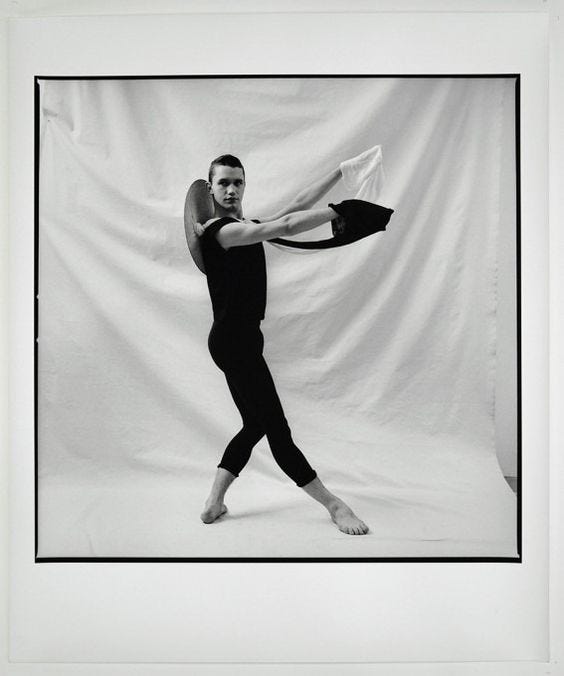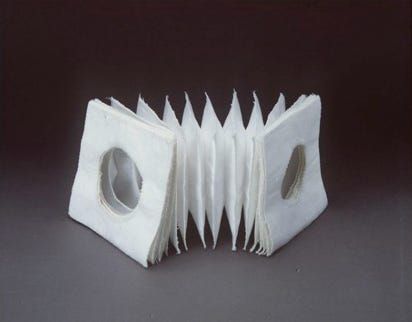The 1980s witnessed a radical shift in experimental jewellery which came to be called the ‘New Jewellery’ movement. The limits and forms that had defined jewellery were tested, now jewellery’s relationship to the body and clothing was investigated and questioned. This in turn led some jewellers to performance based work and photographic jewellery events where control over aspects of wearing jewellery were fixed in a single image.
During this period experimental jewellery for a few European artists merged into what came to be described as ‘wearables’ which began to be exhibited in art galleries across Europe. One of the most influential galleries showing experimental jewellery and wearables was Galerie Ra in Amsterdam, started by jeweller and artist Paul Derez. Key jewellery artists pioneering this shift from jewellery to wearables were Susanna Heron, Caroline Broadhead and Julia Manheim.
The artist Susanna Heron describes how she began to define and exhibit her work during this period…
‘Between September 1981 and April 1982 my work began to fall into two categories: those pieces which I made with the intention that they should be worn I defined as 'wearables'; the parallel group of work takes the use as the subject of the work and has recently developed as sculpture. The Wearables have always been exhibited alongside photographs of them being worn, taken specifically for this purpose by David Ward’
Around the same period Julia Manheim was exploring jewellery as body sculpture using non-precious materials. In her most acclaimed collection 'Wire Wear', she explored the ‘edges of where jewellery meets clothing’ through body jewellery made of plastic-coated steel wire.
Caroline Broadhead’s work at this time was inspired by her experiences with embroidery in Kenya. One of the most significant of these works is ‘Veil Neckpiece’, 1982 in which lavender monofilament envelops the wearer in a woven spiral. These woven pieces —Necklace/Veil, Propellor, Sleeve—were taking over more space on the body and all had strong connotations with clothing.
Caroline Broadhead describes this transition in her work….
'I had an exhibition at galerie Ra -I offered the shirts but i knew I was walking on tricky ground.... there was a feeling from that exhibition that I had actually gone over the boundary. I was now doing clothes - so what was I going to do ? It was a very difficult category. It wasn't going to be fashion: No question of producing things for each season! and there wasn’t this category called ‘art clothing’
‘I am using the characteristic scale proportions and features of garments and the familiarity of these to make clothing forms that express movements aspirations, dilemas, states & so on… my interest in clothing is because of its closeness to the human being without being a portrait or a study or anything literal’ - Caroline Broadhead.
For a few years after this initial exhibition at Galerie Ra, Broadhead showed her ‘art clothing’ pieces in jewellery exhibitions, however she felt this was the wrong environment. She describes feeling like she was cheating the viewer, they had gone to see a jewellery exhibition - yet here was a garment….it didn’t seem like the right place for it.
In 1986 the exhibition ‘Conceptual Clothing’ was curated by two artists, Fran Cottell and Marian Shoettle for Ikon Gallery in Manchester. The artists featured were exploring the relationship between artwork and the body, producing work within a clothing framework and/ or using textiles as the medium. Caroline Broadhead, Susanna Heron and Marian Schoettle were amongst those featured.
This exhibition was staged at a time when ‘material’ was not considered an appropriate medium for fine artists. The Ikon gallery had to amend its constitution in order to be able to host the show, as some of the work was considered to be ‘craft’.
In the catalogue for Conceptual clothing the works are described thus..
‘Clothing is the material and conceptual substance that defines and thereby distinguishes the public and the cultural from the private and the naked. The artists whose work is presented in this show ...have taken clothing from its everyday context and re-presented it as slightly different, more generic, more abstract and even non-material, yet still very familiar.’
Reactions to this exhibition were mixed, reflecting the fraught and perhaps uncomfortable relationship between clothing and the art world and the continuing question of what defines something as craft vs art.
Caroline Broadhead best sums up the reaction to wearables and art clothing in context of an art gallery -
‘This work is still resistant to the language of art criticism, perhaps because the works own social language are still saturated with meanings that we assume but seldom speak in’


















